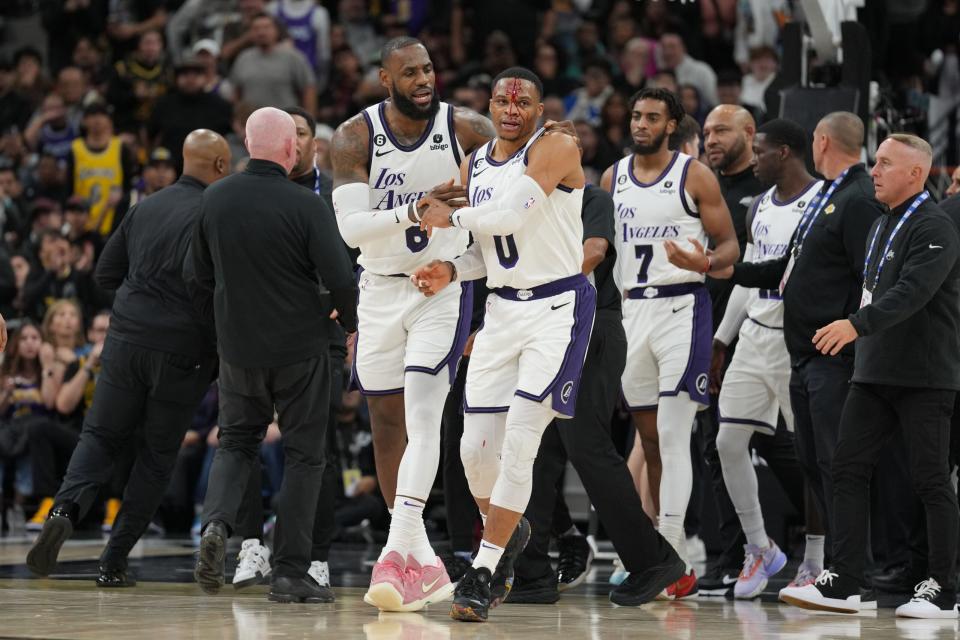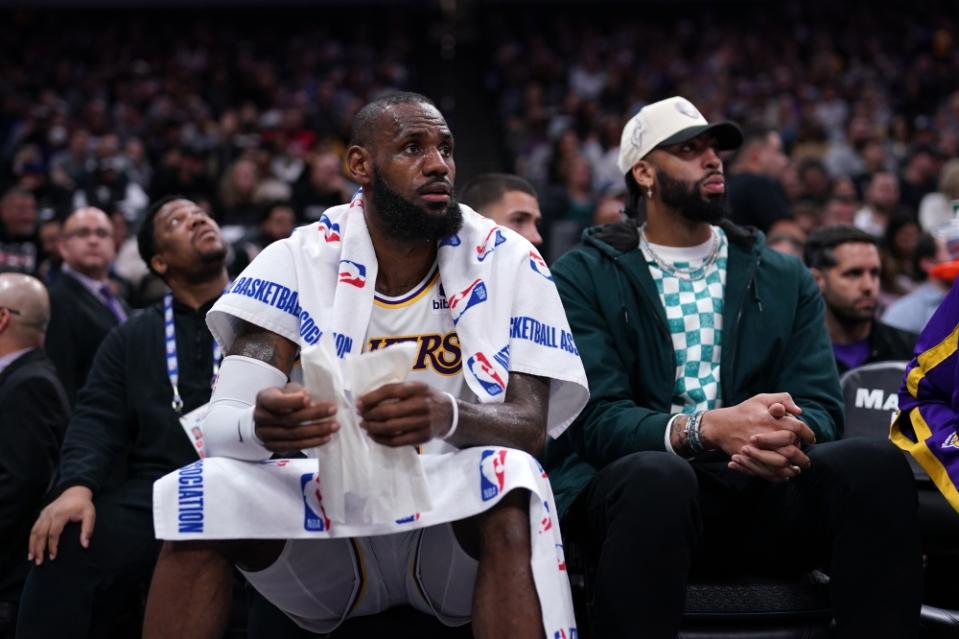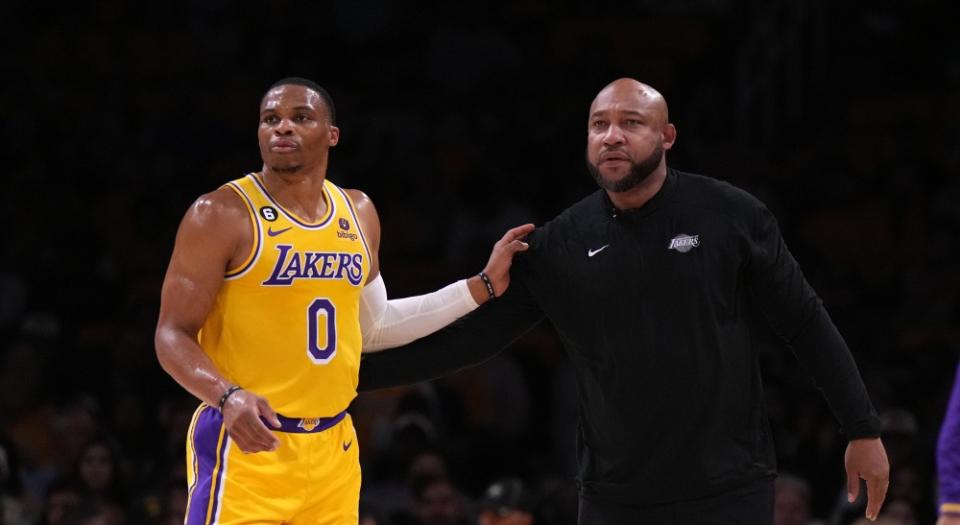Why the Lakers are better off trading for players NOW

The Lakers are heading toward a pivotal moment with their roster construction. This iteration of the Lakers is set to look different with Russell Westbrook’s $47.1 million salary set to expire. They are projected to have around $30 million in cap space this summer if they do not add any salaries beyond this season. They will be naturally looking out for upgrades for this season in the trade market but might not get anything done if they plan to keep their cap flexibility open for this summer.
But what if the Lakers forego cap space and instead trade for multiple players under contract and remain over the cap next season? While the allure of cap space is always promising, there are several reasons why they may be better off avoiding that path as long as they intend to compete with LeBron James and Anthony Davis.
The case against cap space

Cary Edmondson-USA TODAY Sports
The Lakers are projected to generate a little over $30 million in cap space this offseason while only having five players on the roster. This projection factors in the Pelicans’ first-round pick falling in the 25-30 range and Damian Jones picking up his player option worth $2.6 million. They will then have to fill up at least nine more roster spots before the start of the regular season.
If they intend on pursuing an All-Star this summer they may be priced out of doing so. $30 million used to be enough to sign most players to a maximum contract several years ago but now it’s less than even the lowest tier maximum salary amount, projected at $33.5 million for 2023-24. This means they could be out of the race for free agents like James Harden, Kyrie Irving, Draymond Green, Khris Middleton, and Fred VanVleet.
They can go after sub-All-Star players like Myles Turner, Nikola Vucevic, Jerami Grant, Kyle Kuzma, and Gary Trent Jr., but they’ll still take up most of their spending power. This would mean that the Lakers roster would still end up being filled with mostly minimum players. Depth has been their biggest issue these past two seasons where they’ve rostered 8-10 minimum players. This model of team building isn’t sustainable and they need to steer out of it for a more balanced roster filled with fairly paid role players.
Unfortunately, it’ll be challenging to field a deep roster with just $30 million in cap space. In 2019 the Lakers were able to successfully do so with that amount but the talent pool was much stronger in that class. They can spend their cap space and then re-sign Austin Reaves to a lucrative deal but the same mechanics won’t work with bringing back Lonnie Walker IV. Re-signing him would cut into their available cap space amount.
Several wings and guards they could target include Josh Hart, Seth Curry, Caris LeVert, Victor Oladipo, Donte DiVincenzo, and Jae Crowder, to name a few. Afterward, they’ll have the room mid-level (MLE) to add another player projected at $5.8 million. While many of the players mentioned above would be upgrades, the free agency market could still be competitive for them. There’s no guarantee that the Lakers will be able to sign multiple impactful players within their total spending power, making the free agency path a risky one.
One of the big criticisms of the Lakers becoming a cap space team is that it would allow them to avoid the luxury tax next season and delay being in the repeater tax to at least the 2024-25 season. But with James and Davis set to earn $46.9 and $40.6 million respectively, their best chance towards contention would require a willingness to spend. This means maximizing their spending power now by adding significant salary for next season and being deep in the repeater tax.
The case for adding multiple role players now

Kirby Lee-USA TODAY Sports
The Lakers might be better off trading for several role players before the trade deadline for several reasons. For starters, they would have more flexibility in terms of the salaries they are allowed to take on in a trade. For example, they can take back up to $58.9 million in salaries for Westbrook this season alone, nearly double the spending power they have in the upcoming offseason. This process would allow them to get much deeper than with cap space.
Not all players they acquire have to be under contract for next season as they can also re-sign expiring players with their Bird rights. They could then add another player with one of the MLE amounts. For comparison, the cap space route with the room MLE could realistically net the Lakers three total rotation players while the trade route could add more this season plus a more valuable player in the offseason with a higher MLE.
The Lakers would have to give up assets if they move any of their expiring players for significant upgrades to this season’s roster but the opportunity cost is low. Any such deal could just be a half measure so they have a justification to hold onto their two tradeable first-round picks for now. But if they take on unwanted salaries beyond this current season from other teams, they could potentially get some assets attached. Adding more draft picks or prospects gives them a better chance at upgrading the roster through trade later.
There are several teams that could be looking to get off long-term money ahead of the trade deadline. New York is open to moving Derrick Rose and Cam Reddish but also would probably like to get off Evan Fournier as well. Dallas might want to find new homes for Tim Hardaway Jr., Davis Bertans, and JaVale McGee. Charlotte would probably like to offload Gordon Hayward and players like Terry Rozier, Kelly Oubre, Mason Plumlee, and Jalen McDaniels are expected to receive interest.
These are just some hypothetical frameworks where the Lakers would be able to turn a combination of their expiring contracts for players that would eliminate their cap space for this summer. They could also help make the Lakers deeper this season and depending on the structure of the deal, save money against the luxury tax. A structure where they get assets attached would be worthwhile.
However, maximizing their payroll by trading their expiring contracts for as much salary as possible, signing someone with the MLE, and re-signing players like Austin Reaves and Lonnie Walker IV could put them deep into the tax next year. This path could have their luxury tax penalty approach 9 figures, but it gives them a much better chance at contending again.
One other issue if they head into the offseason as a cap space team is that they could miss out on possible trade opportunities. For example, if a player like Zach LaVine or Bradley Beal were to become available, the Lakers would not have a chance to acquire them with their cap space. That’s because their $30 million in cap space won’t be enough to absorb such an expensive player.
While several of the trade candidates listed earlier may not be contributors, their contracts still have utility for salary matching in future trades. Such players would keep the Lakers in the mix to make a big trade in the offseason. If this path interests them they’ll need to load up on players under contract for 2023-24 ahead of the February 9 trade deadline. That’s because they won’t be able to move any of their players on expiring contracts once the deadline passes.
One alternative to this is trading Westbrook now in an uneven trade with the where they create a large trade exception. But that can cost them assets and any players they acquire within the trade exception can’t be aggregated in a trade for two months, meaning they could still miss out on July trade opportunities.
TL;DR
The Lakers should consider trading for multiple role players now instead of taking their chances in free agency. This gives them more spending power towards deepening the roster, could allow them to add assets, and keeps them in the mix for potential offseason trades.
You can follow Yossi Gozlan (@YossiGozlan) on Twitter.
[listicle id=1864449]
[listicle id=1855445]
[listicle id=1735645]

